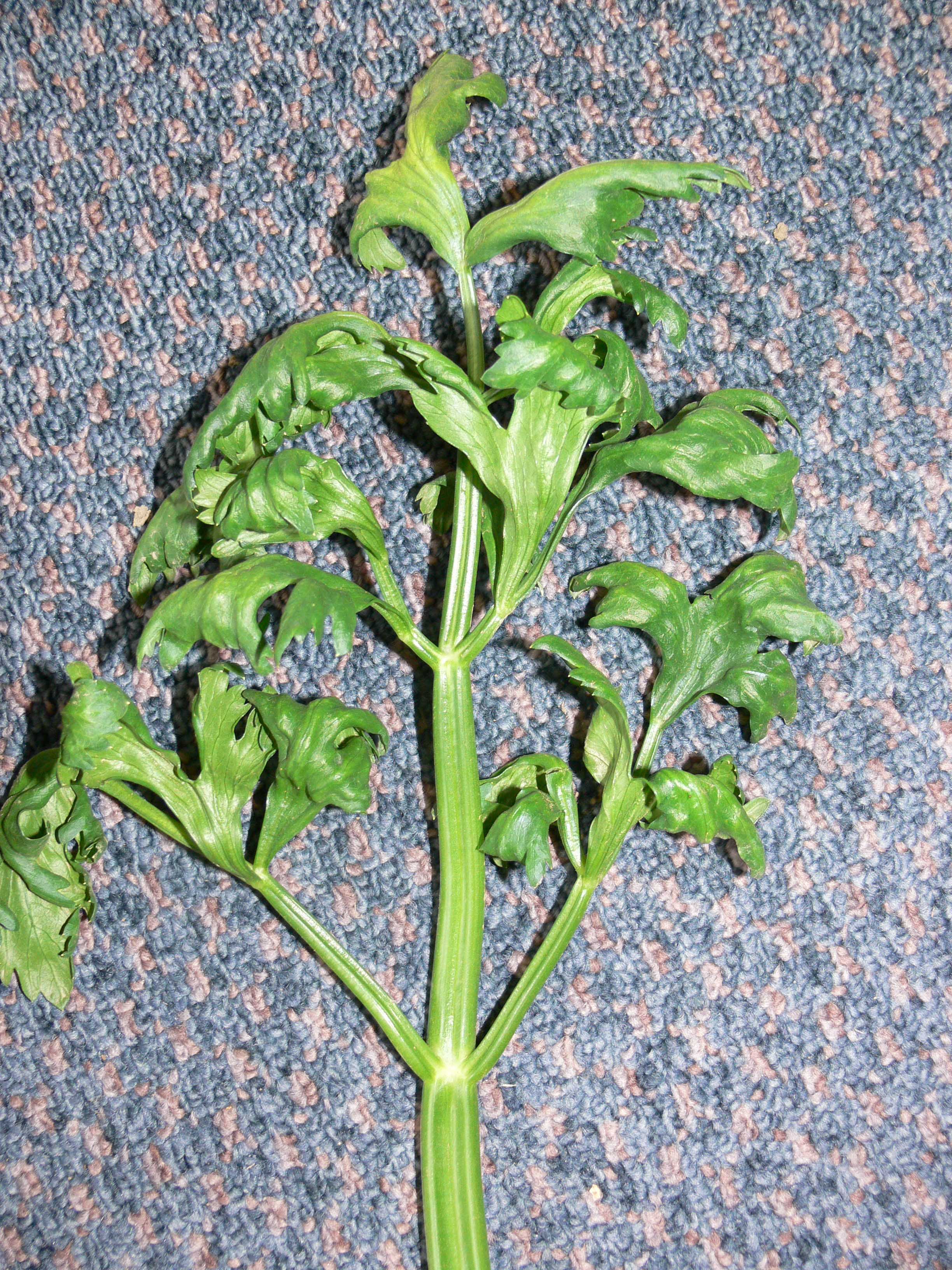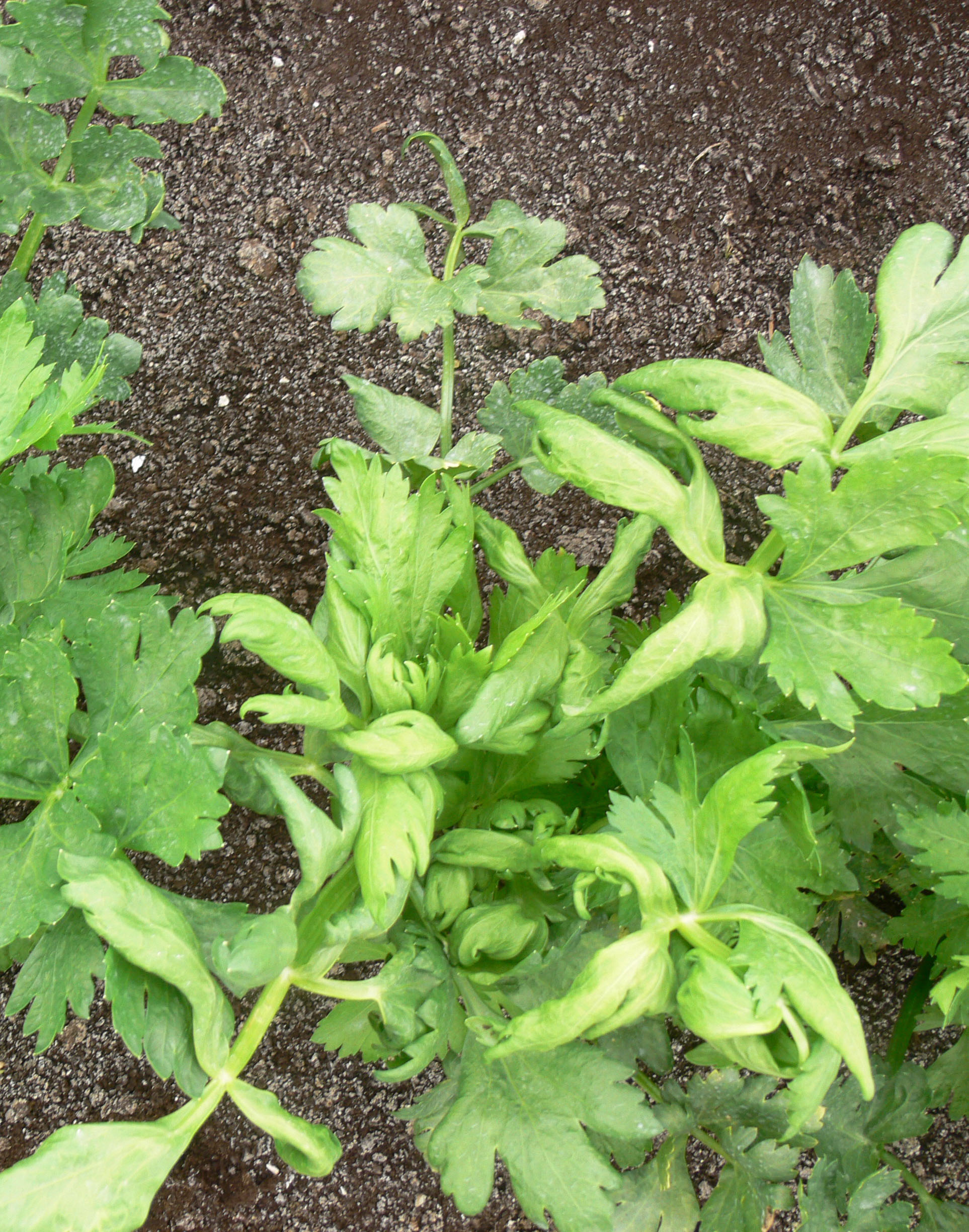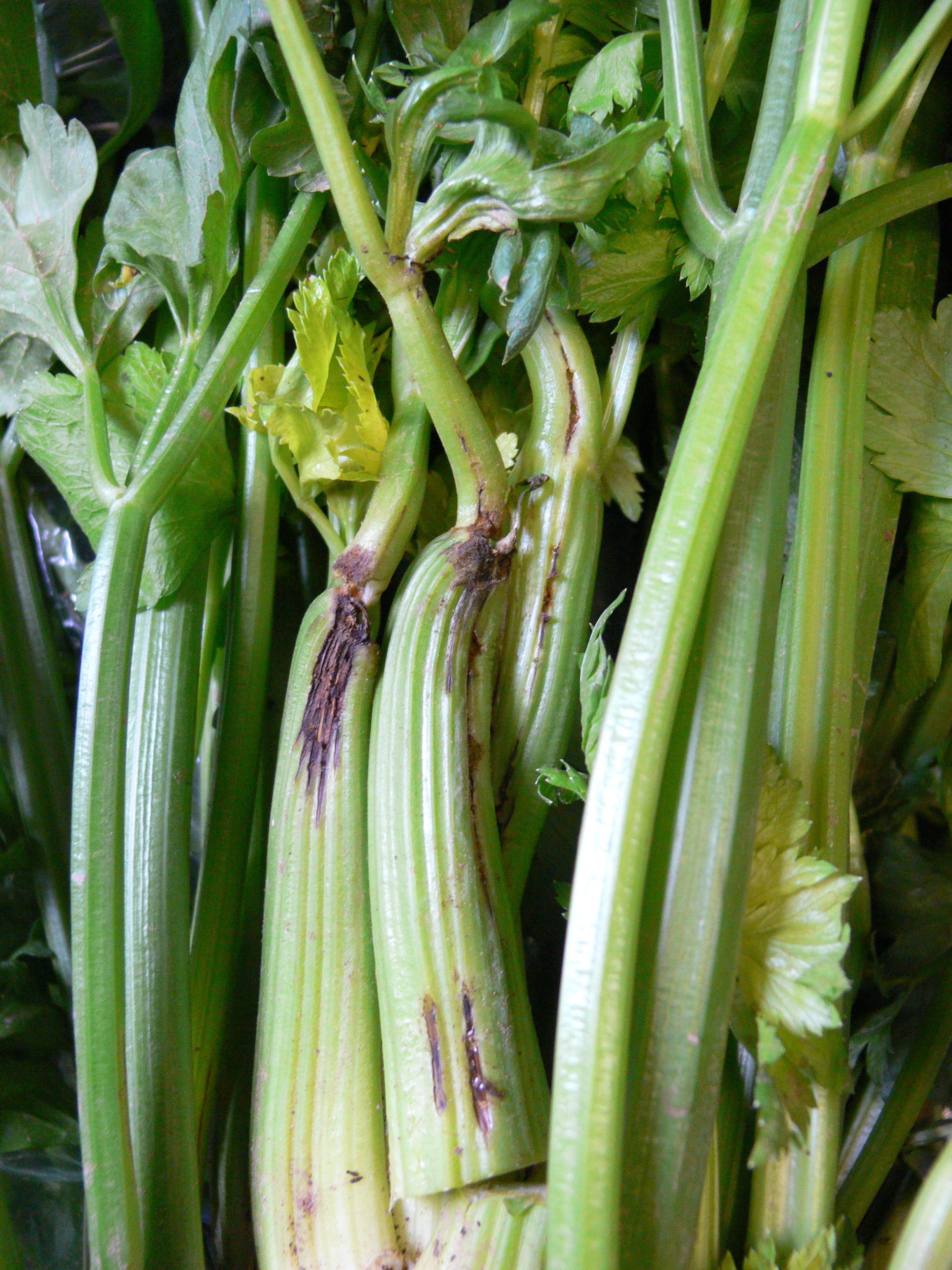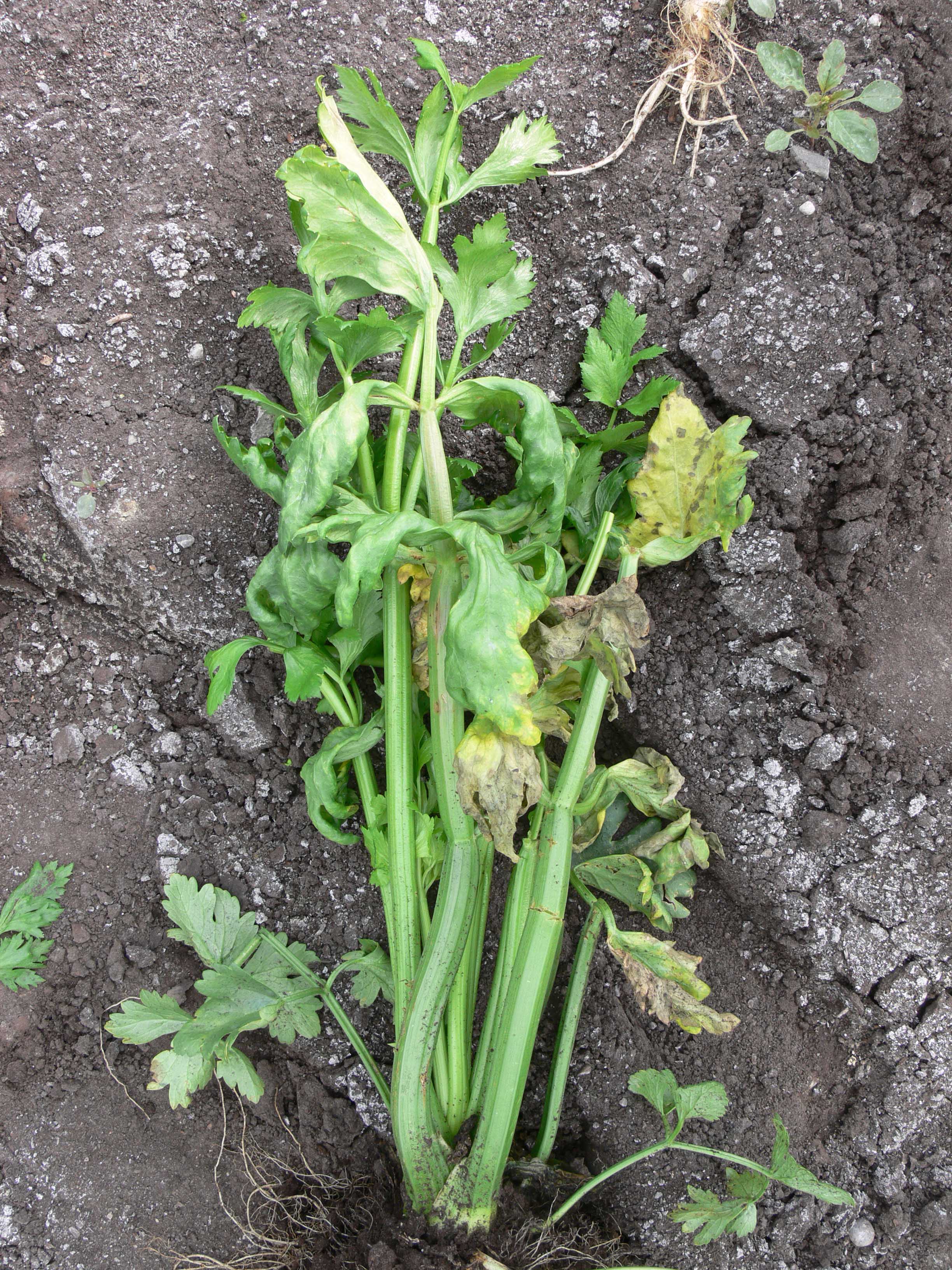Celery leaf curl (anthracnose)
Learn about the symptoms, biology, spread and management strategies for celery leaf curl.
ISSN 1198-712X, Published February 2022
Introduction
Celery leaf curl is caused primarily by the fungus Colletotrichum fioriniae. This disease can also be referred to as anthracnose. Celery leaf curl was first identified in Ontario in 2012. Infected celery plants are unmarketable due to leaf malformation and lesions on the stalks (Figure 1). The leaves, stalks and crown are all susceptible to infection. Leaf curl occurs every year in Ontario and can cause severe crop loss when temperatures are warm and wet. This fact sheet describes the symptoms, biology, spread and management strategies for celery leaf curl.
Symptoms
Characteristic symptoms of celery leaf curl are downward cupped leaves that are small and twisted (Figures 2 and 3), hence the disease name. This can look similar to 2,4-D herbicide injury, but the leaf cupping will always be downwards, whereas the herbicide injury can result in upward cupping.
As the infection progresses, brown lesions develop on leaf margins and tan-to-brown cracks and streaks develop on the celery stalks (Figure 4). As stalks grow, they become twisted and brittle, and growth slows. Crown rot often develops along with adventitious roots — roots that form from any nonroot tissue — along the stalk. Once the fungus infects the celery crown, it will cause stunting and in severe cases, plant death (Figure 5).
Crown rot symptoms are similar to blackheart, caused by weather-related calcium deficiency. The leaf curling symptoms can also be mistaken for early symptoms of aster yellows. To properly identify leaf curl, send samples to a diagnostic lab.





Pathogen biology and spread
Colletotrichum fioriniae is the main Colletotrichum species associated with leaf curl in Ontario and other northeastern states and provinces. Other species, including C. nymphaeae, the causal agent of anthracnose in strawberry, can cause leaf and stalk lesions and crown necrosis on celery, but has not been found to be the primary cause of leaf curl in plants collected from the field in Ontario.
Colletotrichum fioriniae has been isolated from non-celery host plants. Apples are the main crop where C. fioriniae causes the disease bitter rot. Weed hosts identified in Ontario include lamb’s quarters, redroot pigweed, common groundsel and oakleaf goosefoot. Landscape plants such as peony and box elder (Manitoba maple) have also been shown to be good hosts. Research has shown that C. fioriniae isolated from these other hosts can cross-infect, and these weed and landscape hosts could serve as inoculum sources for celery.
Temperatures from 25°C–30°C are optimum for disease development. Sporulation is triggered when at least 12 hr of leaf wetness have occurred. Immature leaves are more susceptible to infection than mature leaves. Colletotrichum species can have a long latent infection, meaning an infected plant may not show any symptoms for days to weeks.
Spores are moved by splashing during rain or irrigation. Driving winds can move spores, but in general, spores do not travel well in wind. People and equipment can easily spread spores across fields and to other fields. Fields should be dry before worker and equipment entry to limit the spread. Research has shown that paraquat, a desiccant herbicide, can trigger a release in spores from weed hosts.
Colletotrichum fioriniae can overwinter as mycelium on leaf residue. Seed can be infected and result in symptomatic or asymptomatic transplants. Overwintered mycelium can infect transplants the following spring. The pathogen survives on celery and non-hosts without producing symptoms, allowing inoculum to build up throughout the season.
Management strategies
Practice integrated pest management strategies for celery leaf curl. This includes integrating cultural, biological, physical and/or chemical controls that have proven efficacy on this disease.
Before planting
Growers should practice a 3–4-year crop rotation with non-host crops. Weed management is important in all crops as they can continue to harbor this disease in the absence of celery. Inspect and remove symptomatic seedlings prior to transplanting in the field. Keep transplants from different locations separate. Allow for good airflow and avoid prolonged periods of leaf wetness.
Seed treatment with a registered fungicide on Colletotrichum spp. may help reduce disease development. Research has shown that a hot water treatment at 50°C for 30 minutes was the best method to eradicate the celery leaf curl pathogen from seeds without significantly impacting germination. Some seed companies routinely use hot water to treat seed and may produce seed in regions with low disease pressure. Check with your seed company about seed treatments.
Cultivar susceptibility
While all cultivars appear susceptible to infection, there are differences in susceptibility. Research reports from the Ontario Crops Research Centre, Bradford, from 2015 to 2018, suggest the following levels of susceptibility:
Tolerant:
Merengo, Balada
Tolerant to moderately tolerant:
TZ 6010, Sabroso
Moderately tolerant to susceptible:
Hadrian, Geronimo
Susceptible:
Stetham, TZ 0295, TZ 6200, TZ 6029
Susceptible to highly susceptible:
Kelvin, Nero, TZ 9779
Highly susceptible:
Plato
During the season
Scouting for celery leaf curl should include recording the location of diseased plants within a field. If a plant showing symptoms is touched, pause scouting and remove plants by placing them in a garbage bag for identification and replace gloves. Once leaf curl has been identified in the field, continue to remove infected plants from the field using a plastic garbage bag. Manage irrigation to reduce the length of time the canopy is wet, for instance, irrigate at night when there would be dew on the leaves or irrigate in the early morning so wet leaves will dry quickly.
Fungicides can be effective when applied before infection and reapplied when conditions are favourable. Registered fungicides as of 2022 for control of celery leaf curl include:
- Switch 62.5 WG (cyprodinil – group 9
+ fludioxonil – group 12) - Quadris Flowable (azoxystrobin – group 11)
Other fungicides registered on celery may have efficacy on leaf curl, including:
- Pristine (boscalid – group 7
+ pyraclostrobin – group 11) - Luna Sensation (fluopyram – group 7 + trifloxystrobin – group 11)
- Flint (trifloxystrobin – group 11)
- Bravo ZN/Echo 90DF (chlorothalonil – group M5)
Refer to publication 838, Vegetable Crop Protection Guide, for more information. Always read and follow the pesticide label.
Weather-based forecasting models for celery leaf curl have been developed in Ontario on susceptible varieties (TZ6200 and Kelvin). Using the TOMCAST system, fungicide applications at disease severity value (DSV) 15 resulted in similar disease severity as calendar sprays with fewer fungicide applications. Using TOMCAST at DSV 15 allows for fungicide applications when favourable weather conditions persist and reduce the amount of unnecessary fungicide applications.
If a field of celery has been infected, deep-plow residue immediately after harvest to encourage breakdown of plant debris.
Fungicide resistance management
Fungicides can be an important tool in managing celery leaf curl. Resistance management needs to be followed for fungicides. Colletotrichum spp. including C. finoriniae and C. nymphaeae are at high risk of developing resistance. Group 11 fungicides (azoxystrobin, pyraclostrobin, trifloxystrobin) are at high risk of resistance development. Resistance management practices are very important for this disease in celery to maintain the efficacy of these products.
Alternating effective fungicide groups is the most important approach. Products containing group 11 fungicides (Quadris, Pristine, Luna Sensation and Flint) cannot be applied in succession. Where possible, tank-mix group 11 fungicides with a group M fungicide (for example, mancozeb or chlorothalonil) or another effective group. This reduces the selection for resistance on each individual fungicide. If using a solo group 11 (Quadris, Flint), do not use these in more than one-third of all fungicide applications. If using a mixture where both actives are efficacious on the disease, do not use a group 11 in more than half the number of applications.
Additionally, keeping the celery crop as healthy as possible and using other management strategies such as tolerant cultivars can help reduce the reliance on fungicides for managing leaf curl.
Additional web sources
- Ontario Crops Research Centre – Bradford | (uoguelph.ca)
- University of Massachusetts Amherst, Celery, Anthracnose
- Cornell University, Celery Anthracnose (Leaf Curl Disease)
References
- Liu, B., Pavel, J. A., Hausbeck, M. K., Feng, C., & Correll, J. C. (2021). Phylogenetic Analysis, Vegetative Compatibility, Virulence, and Fungal Filtrates of Leaf Curl Pathogen Colletotrichum fioriniae from Celery. Phytopathology, 111(4), 751–760. https://doi.org/10.1094/PHYTO-04-20-0123-R
- McDonald, MR., Vander Kooi, K., Reynolds, S., Celetti, M., Jordan, K. and Pauls, P. Muck Vegetable Cultivar Trial and Research Reports – 2015 to 2019. Retrieved from https://bradford-crops.uoguelph.ca/publications/cultivar-trial-and-research-reports
- Yamagishi, N., Fujinaga, M., Ishiyama, Y., Ogiso, H., Sato, T., & Tosa, Y. (2015). Life cycle and control of Colletotrichum nymphaeae, the causal agent of celery stunt anthracnose. Journal of General Plant Pathology: JGPP, 81(4), 279–286. https://doi.org/10.1007/s10327-015-0598-7
This fact sheet was written by Katie Goldenhar, pathologist, horticulture, and Travis Cranmer, vegetable crop specialist, Ontario Ministry of Agriculture, Food and Rural Affairs.